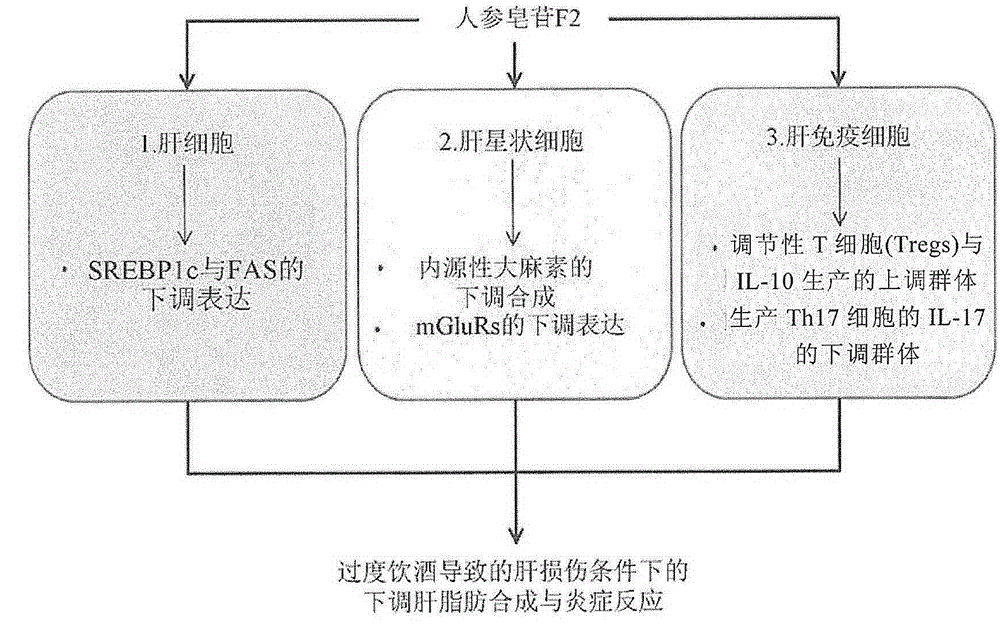Use Of Ginsenoside F2 For Prophylaxis And Treatment Of Liver Disease
A technology of ginsenosides and uses, applied in the field of liver disease prevention or treatment of ginsenoside F2, which can solve the problems that the therapeutic effect of ginsenoside F2 on liver diseases has not been revealed
- Summary
- Abstract
- Description
- Claims
- Application Information
AI Technical Summary
Problems solved by technology
Method used
Image
Examples
Embodiment 1
[0074] Embodiment 1. The effect of alleviating the liver damage caused by alcohol and inhibiting the formation of fatty liver
[0075] The 8-week-old male rat (weight is 25~28g) is fed normally for two weeks, and at the same time, the ginsenoside F2 (expressed as GF2 in the accompanying drawing) of 50mg / kg is dissolved in the ethanol of 3g / kg and in the afternoon every day It was orally administered to male mice at about 3-4 o'clock, and the male mice were killed two weeks later to perform the following experiments.
[0076] The preparation method of ginsenoside F2 is as follows. Put the leaves and roots of other ginseng including Korean ginseng, American ginseng, and bamboo ginseng into 20 times the volume of 80% alcohol, extract twice or more, and dry to obtain crude saponins. The crude saponin was dissolved in water again, and after being adsorbed to HP-20 resin, 100% water was used to wash to remove sugar, and then 40% alcohol was used to wash once to remove preferentiall...
Embodiment 2
[0091] Example 2. Experiments on co-cultured hepatocytes and hepatic stellate cells
[0092] (1) Inhibition of fat synthesis in hepatocytes and hepatic stellate cells
[0093] Such as Figure 5a In the schematic diagram shown, after isolating mouse hepatocytes and hepatic stellate cells, hepatic stellate cells (HSCs) were placed on the bottom surface of the lower side and hepatocytes were placed on the upper side, and co-culture was carried out. When culturing, 100 mM ethanol was treated for 12 hours, and then 30 μM ginsenoside F2 was treated for 6 hours or 12 hours.
[0094] Figure 5b The results of Western blotting were performed on co-cultured hepatocytes recovered. Unlike the hepatocytes treated with ethanol alone, the expression of fat-reducing pAMPK was increased, and conversely, the expression of fat-synthesizing SREBP1c and FAS was decreased in the case of simultaneous treatment with ginsenoside F2.
[0095] Figure 5c It is the result of real-time PCR of co-cult...
Embodiment 3
[0101] Example 3. Inhibitory effect of liver inflammatory changes by increasing regulatory T cells
[0102] Rats were fed normally for two weeks, and at the same time, 3 g / kg was administered to each individual for two weeks. At this time, the vehicle was administered to the first group (E+Veh), and ginsenoside F2 was administered to the second group (E+GF2).
[0103] Thereafter, mononuclear cells were isolated from the liver, and stained with macrophage markers CD11b and F4 / 80 for flow cytometry analysis. As a result, it was confirmed that the proportion of macrophages decreased when treated with ginsenoside F2 ( Figure 6a ), flow cytometry analysis was carried out by staining with markers CD11b and Gr-1 of neutrophils, and it was confirmed that when ginsenoside F2 was used for treatment, the proportion of neutrophils decreased ( Figure 6b ). Macrophages and neutrophils are cells closely related to inflammatory response, so it can be seen that ginsenoside F2 can relieve i...
PUM
 Login to View More
Login to View More Abstract
Description
Claims
Application Information
 Login to View More
Login to View More - R&D
- Intellectual Property
- Life Sciences
- Materials
- Tech Scout
- Unparalleled Data Quality
- Higher Quality Content
- 60% Fewer Hallucinations
Browse by: Latest US Patents, China's latest patents, Technical Efficacy Thesaurus, Application Domain, Technology Topic, Popular Technical Reports.
© 2025 PatSnap. All rights reserved.Legal|Privacy policy|Modern Slavery Act Transparency Statement|Sitemap|About US| Contact US: help@patsnap.com



